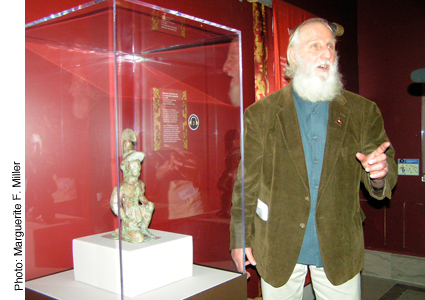Exploring and Interacting with the Silk Road's Artifacts |
|
,
|
 |
Above, a bronze figurine of a kneeling warrior, c. 500 BCE, with Dr. Victor Mair, Penn professor of Chinese language and literature, who was the first Westerner to draw attention to these objects. He also co-authored the book, Tarim Mummies, organized the March 19 international symposium, edited the Silk Road catalog and curated the exhibit. |
The Secrets of the Silk Road exhibition is now open at the Penn Museum with the mummies and artifacts from China. The Museum recently announced that its landmark exhibition would belatedly include the full complement of artifacts and mummies for a limited time. (See photos below) Since reopening the exhibit last Friday, the Museum has extended day and evening hours to accommodate those who wish to experience this extraordinary exhibition during its run. (See Update February AT PENN.)
The rare artifacts and mummies—making their exclusive East Coast appearance—will be on display in the Museum’s exhibition presentation developed exclusively for Philadelphia and will run through March 15. Then, from March 17 through 28, the exhibition will continue, with all the artifacts but without the two mummies.
“We are delighted to be able to present the complete range of this spectacular material,” said Dr. Richard Hodges, the Williams Director of the Penn Museum. “Secrets of the Silk Road is an historic, must-see exhibition—and we encourage people to make sure to come to the Penn Museum during its limited run.”
“Penn President Amy Gutmann, Provost Vincent Price and I want to extend our deepest appreciation to U.S. Ambassador to China Jon M. Huntsman, Jr., and his wonderful counterpart Zhang Yesui, Ambassador of the People’s Republic of China to the United States, as well as the gracious senior Chinese officials, including State Councilor Liu Yandong, State Councilor Dai Bingguo, Foreign Minister Yang Jiechi, Culture Minister Cai Wu, and Director of the State Administration of Cultural Heritage Shan Jixiang and their colleagues, who have so generously assisted us in making all these artifacts available,” said Dr. Hodges.
The modified exhibition, initially opened February 5 but was closed on February 13 to install the rare and fragile artifacts, some of which are more than 3,800 years old. The exhibition first opened at the Bowers Museum in Santa Ana, California, before being shown at the Houston Museum of Natural Science.
General admission timed tickets (includes admission to the rest of the Museum): adult: $22.50; senior (65+)/military: $18.50; students (full-time with ID)/children (6 to 17 years): $16.50; group discounts are available. For extended group hours, tailored package options and reservations, e-mail grouptickets@museum.upenn.edu or call (215) 746-8183 or visit www.penn.museum/silkroad
 |
Pam Kosty, assistant director, Public Information, Penn Museum, at the Press Preview. |
 |
Dr. Victor Mair, professor of Chinese language and literature, Penn; Mr. Lin Ruihua, Cultural Affairs Office of the Embassy of the People’s Republic of China in the US; Mr. Guo Jianguo, Xinjiang Bureau of Cultural Relics |
 |
Dr. Richard Hodges, the Williams Director of the Penn Museum |
 |
Map of Silk Road Highlights |
 |
Mr. Guo Jianguo, Xinjiang Bureau of Cultural Relics and Dr. Xiuqin Zhou, senior registrar, Penn Museum |
 |
Dr. Victor Mair, Dr. XiuqinZhou, Mr. Lin Ruihua,, Dr. Richard Hodges, and Mr. Guo Jianguo cutting the ribbon to mark the opening of the Silk Road exhibit. |
 |
Embroidered boots, ca 2nd-3rd century AD. From the Xinjiang Uyghur Autonomous Region Museum |
 |
Gold bracelets, 14th century, Excavated from Bortala, Daltu, Xinjiang Uyghur Autonomous Region Museum Collection 0273 |
 |
Skirted dress, ca 5th-3rd century BC, From the Xinjiang Uyghur Autonomous Region Museum |
 |
Two of a group of paint female pottery figures at domestic work. 7th to 9th century, excavated from Astana, Turfan. Part of the Xinjiang Uyghur Autonomous Region Museum Collection. 0281 |
| Photos by Marguerite F. Miller |
|